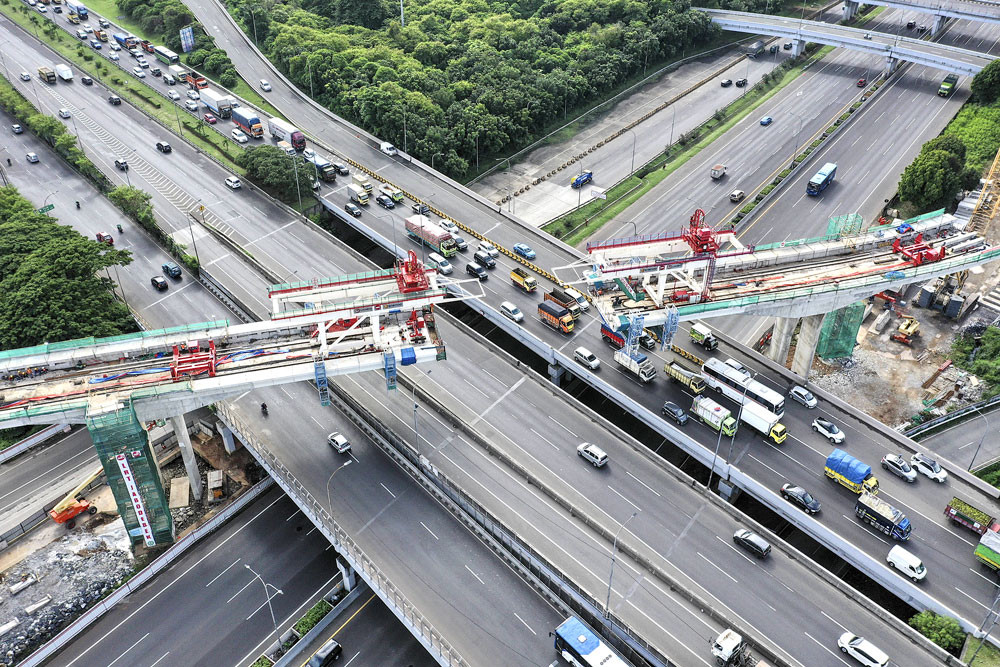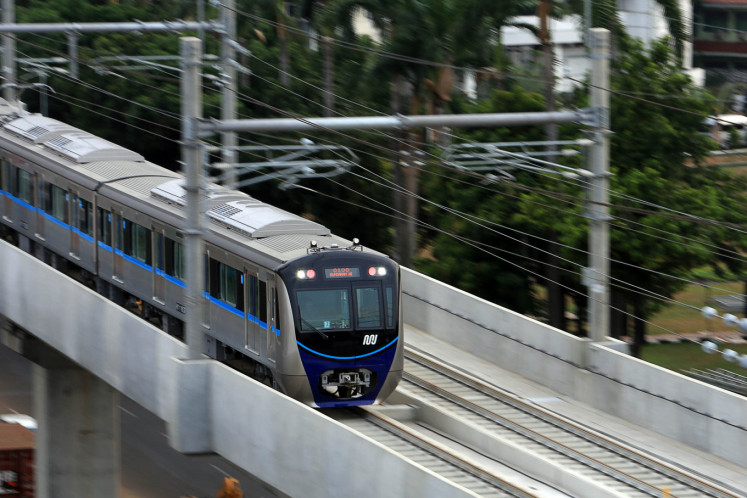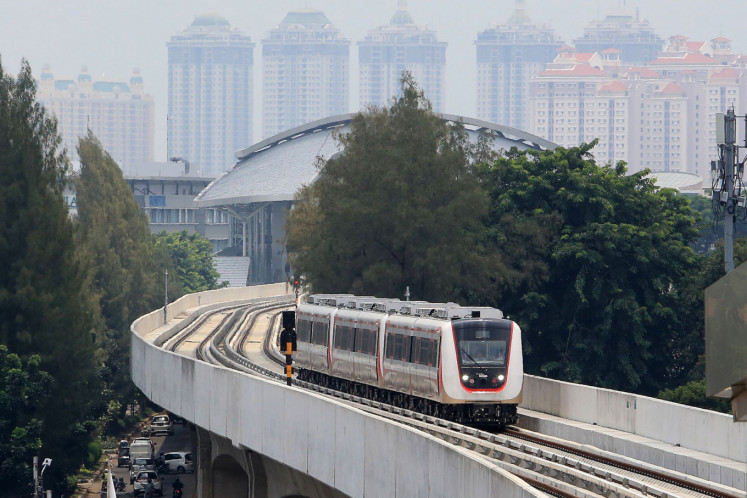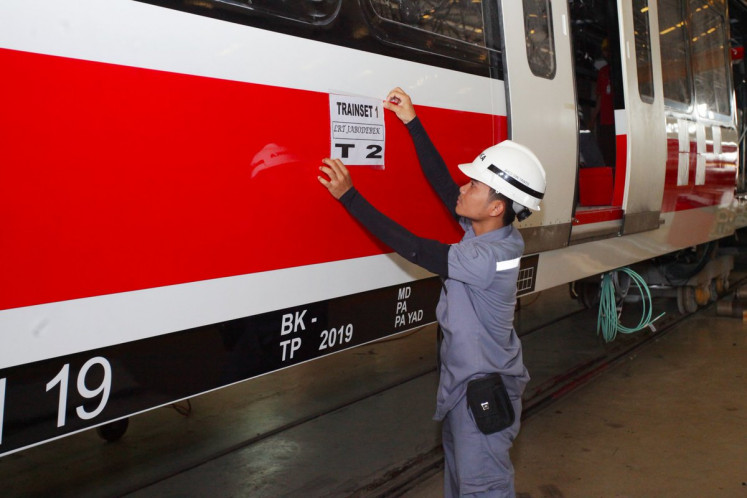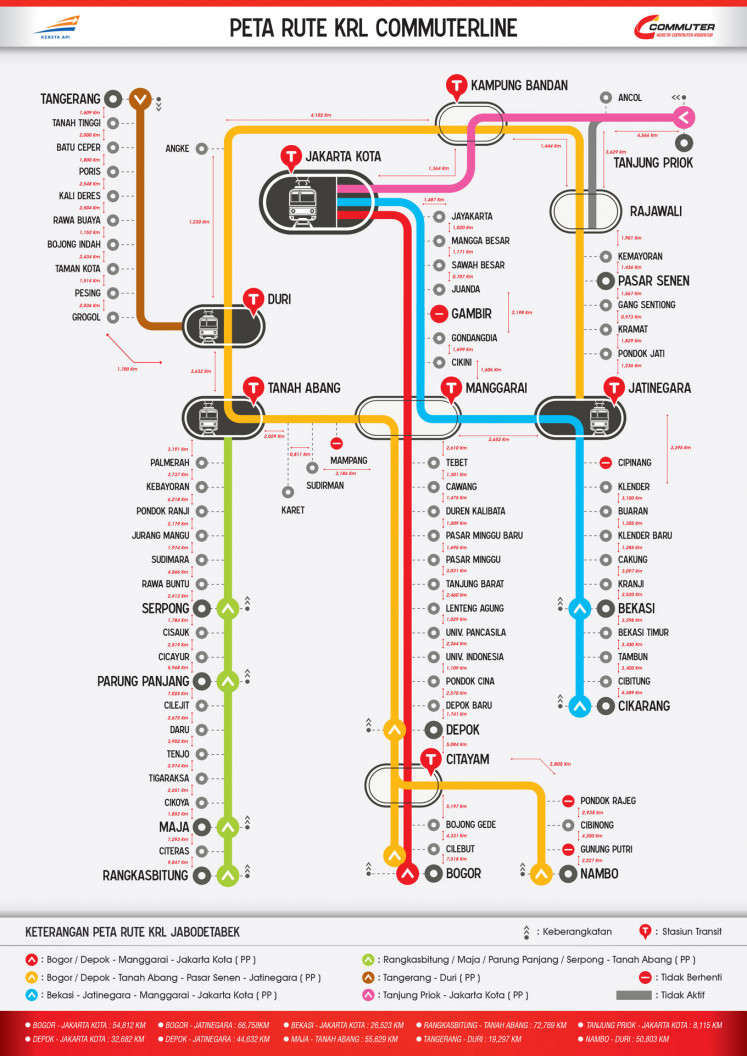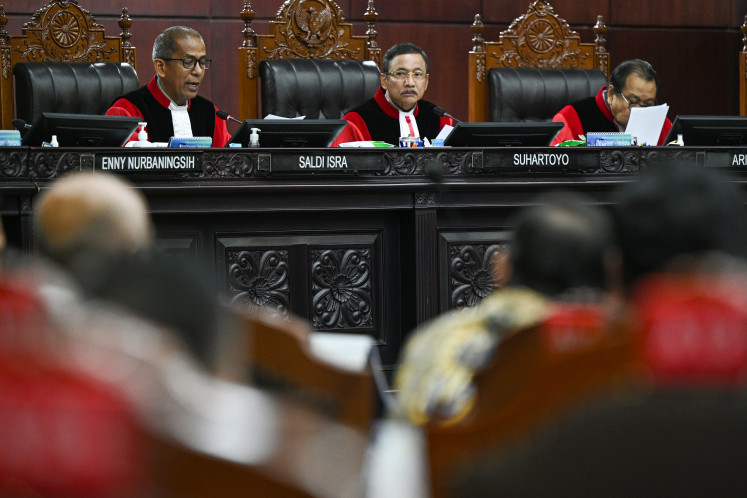Popular Reads
Top Results
Can't find what you're looking for?
View all search resultsPopular Reads
Top Results
Can't find what you're looking for?
View all search resultsNot all trains created equal: Differences between MRT, LRT, Commuter Line
While it is easy to distinguish between buses and trains, all these news trains can get confusing. What is the difference between MRT, LRT Jakarta, LRT Jabodebek and the already-running Commuter Line?
Change text size
Gift Premium Articles
to Anyone
J
akarta, which has topped various lists of cities with the world’s worst traffic, enters a new era this year. Next month, it will welcome the country’s first mass rapid transit (MRT) and the capital’s first light rail transit (LRT).
Today, the usage of public transportation in the capital stands at 24 percent, a far cry from the targeted 60 percent. The government hopes the new transit modes will see more people leave their cars or motorbikes at home and opt for public transportation to get around the city.
This year, in the words of Jakarta Transportation Agency head Sigit Widjatmiko, would be “the year of integration”. Passengers can expect to easily hop between different modes of transportation on a trip.
For instance, LRT passengers who wish to continue their trip with the city’s rapid bus transit system, Transjakarta, can use a skybridge that will connect the LRT Jakarta International Velodrome Station in Rawamangun, East Jakarta, with the Pemuda bus stop. Meanwhile, Dukuh Atas in Central Jakarta is expected to be a transit point for passengers of the MRT, LRT, Commuter Line, airport train and Transjakarta.
While it is easy to distinguish between buses and trains, all these news trains can get confusing. What is the difference between MRT, LRT Jakarta, LRT Jabodebek and the already-running Commuter Line?
Most sophisticated mode in town
The MRT is expected to run by the end of March. The 15.7-kilometer first phase of the MRT is currently at 99 percent completion, connecting Lebak Bulus in South Jakarta and the Hotel Indonesia traffic circle in Central Jakarta. The second phase will link the Hotel Indonesia traffic circle with Kampung Bandan, completing the north-south line, to be followed by the last phase for the west-east line.
Sixteen trains are ready for operation, each consisting of six cars. MRT cars are heavier than those of the Commuter Line, weighing 31 to 35 tons each. The trains are 118 meters long and capable of carrying 1,200 to 1,800 passengers. The MRT is expected to carry 173,400 passengers per day.
The MRT runs at up to 80 kilometers per hour underground and 100 km/h on elevated sections of the line. With the MRT, the journey from Lebak Bulus to Hotel Indonesia will take 30 minutes. With the initial routes and units, the interval between trains is expected to be five minutes.
The MRT Jakarta uses a semi-automated system, where the human operator aboard only controls the doors and departure or any emergencies.
The city administration has yet to announce the fare for the MRT. The proposed fare is Rp 8,500 (59 US cents) per 10 kilometers.
The first phase cost Rp 16 trillion, including the funds to build seven elevated and six underground stations. The second phase is more expensive, estimated to cost Rp 22.5 trillion for 8.3 kilometers, because the route has more underground stations.
The MRT is considered the most sophisticated, because it requires the first-ever construction of underground stations in the country using four tunnel boring machines. The first one even got a name, Antareja I, and was officiated by President Joko “Jokowi” Widodo.
Lightweight, high ambition
Two companies are building the LRT in Jakarta. One is PT LRT Jakarta, a subsidiary of city-owned PT Jakarta Propertindo (Jakpro), and the other is state-owned PT Adhi Karya (ADHI).
The 5.8-km LRT route from Kelapa Gading in North Jakarta to Rawamangun in East Jakarta cost Rp 6.8 trillion. Each train can carry 270 passengers. The LRT is expected to service 66,150 to 76,140 passengers per day and start operating by the end of March. The Jakarta Transportation Council (DTKJ) has proposed a fare of Rp 10,800.
The second phase of LRT Jakarta is planned to connect Velodrome Station in Rawamangun and Tanah Abang in Central Jakarta and is estimated to cost between $500 million and $600 million.
For the first phase, the LRT Jakarta rolling stock, comprising of eight trains, is made in South Korea by train manufacturer Hyundai Rotem for a total of $33 million, according to the International Railway Journal. LRT Jakarta president director Allan Tandiono told the media that each car cost $1.8 million.
LRT systems vary in form, but LRT Jakarta defines it as a train with a maximum axle weight of 12 tons. Conventional trains usually weigh 15 to 18 tons. Each LRT Jakarta train consists of two cars with a total length of 28 meters.
Another LRT system that will operate in Jakarta is LRT Jabodebek, which stands for Jakarta-Bogor-Depok-Bekasi, also known as the Greater Jakarta LRT. Greater Jakarta LRT was initiated by the central government and constructed by ADHI and state-owned railway company PT Kereta Api Indonesia (KAI).
The first phase of the Greater Jakarta LRT spans over 40 km, connecting Cawang in East Jakarta with Cibubur in East Jakarta, Cawang with Dukuh Atas in Central Jakarta and Cawang with East Bekasi in Bekasi, West Java, costing the company Rp 31 trillion.
ADHI works with a transit-oriented development concept it calls “LRT City”, which includes housing and commercial facilities near LRT and Commuter Line stations.
Greater Jakarta LRT ordered the rolling stock from state-owned train maker PT Industri Kereta Api (INKA) in December 2017. The value of the order was Rp 4.05 trillion for 186 cars. For INKA, it was the second order, after the company had produced LRT train cars for the country’s first-ever LRT in Palembang, South Sumatra.
Old and modest, but most popular
The Commuter Line runs on the oldest railway system in the country, built by the Dutch administration. In 2011, PT Kereta Commuter Indonesia (KCI) changed the name of the electric train system from KRL to Commuter Line.
From 2012 to 2013, the state-owned railway company revamped the Greater Jakarta train system, including by evicting traders from several stations. The company, under the leadership of Ignasius Jonan, then the president director of KAI, tightened rules and significantly increased the frequency of trips connecting Bogor, Depok, Bekasi, Tangerang and South Tangerang with Jakarta.
Although it is the oldest system and uses used trains from Japan, it is by far the most popular mode of public transportation in Greater Jakarta, carrying 336.71 million passengers in 2018, up from 315.81 in 2017.
By 2018, the KCI operated 900 trains serving 79 stations in Greater Jakarta, with routes spanning 418.5 km. Each trains consists of eight, 10 or 12 cars.
Running at a maximum 90 km/h, the headway is between 5 and 10 minutes. However, disruptions are common for various reasons, from power and signal failures to accidents at rail crossings, floods or derailed trains.
The fare is Rp 3,000 for the first 25 km, plus Rp 1,000 per every additional 10 km.

